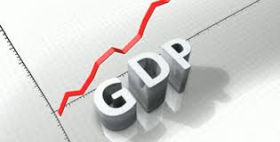Analytics, Economics, GDP, Latvia, Statistics
International Internet Magazine. Baltic States news & analytics
Saturday, 20.04.2024, 08:28
GDP of Latvia has grown by 4 % over the year
 Print version
Print version |
|---|
Changes of GDP volume, %
1seasonally and calendar non-adjusted
2seasonally and calendar adjusted
In the 1st quarter of 2017, GDP at current prices amounted to EUR 5 871.1 mln

Production approach
(at constant prices, seasonally and calendar non-adjusted data)
Changes of GDP in the 1st quarter of 2017 by kind of economic activity

In the 1st quarter of 2017, as compared to the 1st quarter of 2016, the manufacturing section grew by 10%. Growth was recorded in almost all manufacturing divisions, the largest of which are: manufacture of wood and of products of wood – growth of 5%, manufacture of food products – of 2%, manufacture of fabricated metal products – of 14%. Significant growth was also experienced in manufacture of computer, electronic and optical products – of 37%, in manufacture of furniture – of 14% and in manufacture of chemicals and chemical products – of 13%.
There was an 18% increase in the production volumes of mining and quarrying, as well as an 11% increase in electricity, gas, steam and air conditioning supply.
As compared to the corresponding quarter of the previous year, the construction production volume increased by 8% in the 1st quarter of 2017. Growth was experienced in all construction divisions: an increase of 19% in the construction of residential buildings and of 7% in the construction of non-residential buildings, of which there was a 20% upturn in the construction of industrial buildings and warehouses and a 4% rise in the construction of civil engineering structures, including an increase in the construction of harbours and dams (of 48%) and a drop in the construction of highways, streets and roads, airfield runways, and railways (of 24%).

Retail trade experienced growth of 3% in the 1st quarter of 2017, of which retail trade in non-food products increased by 6%, whereas retail trade in food products decreased by 2%. Wholesale increased by 2% during the respective period, while wholesale, retail trade and repair of motor vehicles and motorcycles grew by 24%.
The transportation and storage section experienced growth of 9%, which was facilitated by a 4% increase in passenger traffic, an increase of 8% in freight traffic, as well as an 11% increase in warehousing and support activities for transportation.
Growth of 4% was recorded in accommodation and food service activities, of which 2% in accommodation services and 5% in food services.
Growth of consumer and business prices caused relatively low growth rates in several service sections.
An 11% drop in the section of financial and insurance activities was caused by growth in the proportion of expenditures of the banking division, as well as a 50% drop in the profit from commercial transactions with financial instruments.
The volume of taxes on products (value added tax, excise and customs taxes) increased by 2% in the 1st quarter of 2017, as compared to the 1st quarter of 2016.
Expenditure approach
(at constant prices, seasonally and calendar non-adjusted data)
Changes of GDP in the 1st quarter of 2017 by kind of expenditure

In the 1st quarter of 2017, final consumption expenditure rose by 5%. This was influenced by a 6% increase in private final consumption, where household expenditure on transport (expenditure on public transport, purchase and exploitation of transport vehicles) grew by 11%, on recreation and culture – by 13%, while expenditures on restaurants and hotels grew by 4%. Expenditure on housing has remained at the level of the corresponding quarter of the previous year, whereas expenditure on food decreased by 4%. Final consumption of households was affected by an increase in the income of households. Government final consumption grew by 3%.

After a long downturn, gross fixed capital formation witnessed growth, as it increased by 9% in the 1st quarter of the present year, as compared to the first quarter of 2016. Growth was recorded in all gross fixed capital formation groups: investment in equipment and machinery grew by 14%, dwellings and other buildings and structures – by 5%, and intellectual property products – by 4%. Of the total amount of investments, 20% went to the transportation and storage section. Investments in public administration and defence, compulsory social security amounted to 12%, whereas 11% were invested in manufacturing.
Exports of goods and services have grown by 8% in the 1st quarter, whereas imports have increased by 5%. Exports to EU countries were mainly formed by wood and products of wood and cork (except furniture), as well as food products, whereas the main imports included food products and vehicles.
The growth in exports had a positive impact on the GDP in the amount of 5.0 percentage points, whereas imports decreased the total GDP by 3.1 percentage points.
Income approach
(at constant prices, seasonally and calendar non-adjusted data)
In the 1st quarter of 2017, as compared to the 1st quarter of 2016, compensation of employees grew by 8%. The upturn was facilitated by an increase of compensation of employees in manufacturing (of 8%), in construction (of 6 %), in trade (of 7%) and in communication (of 16%). Compensation of employees formed 49% of the GDP. Gross operating surplus and mixed income increased by 8 %, whereas the balance of taxes on production and imports and subsidies decreased by 7%.
The average real compensation of employees was 3.1% lower than the average gross compensation of employees in the 1st quarter of 2017, which is related to inflation in the amount of 3.2%.
Average compensation of employees

Changes of gross domestic product in the Baltic countries
(at constant prices, seasonally and calendar non-adjusted, % of the corresponding period of the previous year)

*According to the flash estimate on the 1st quarter









 «The Baltic Course» Is Sold and Stays in Business!
«The Baltic Course» Is Sold and Stays in Business!

